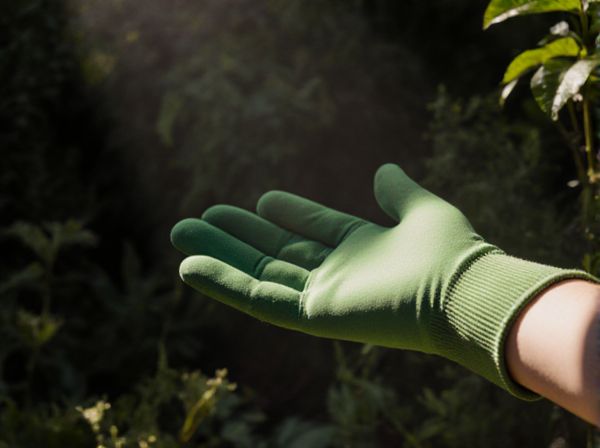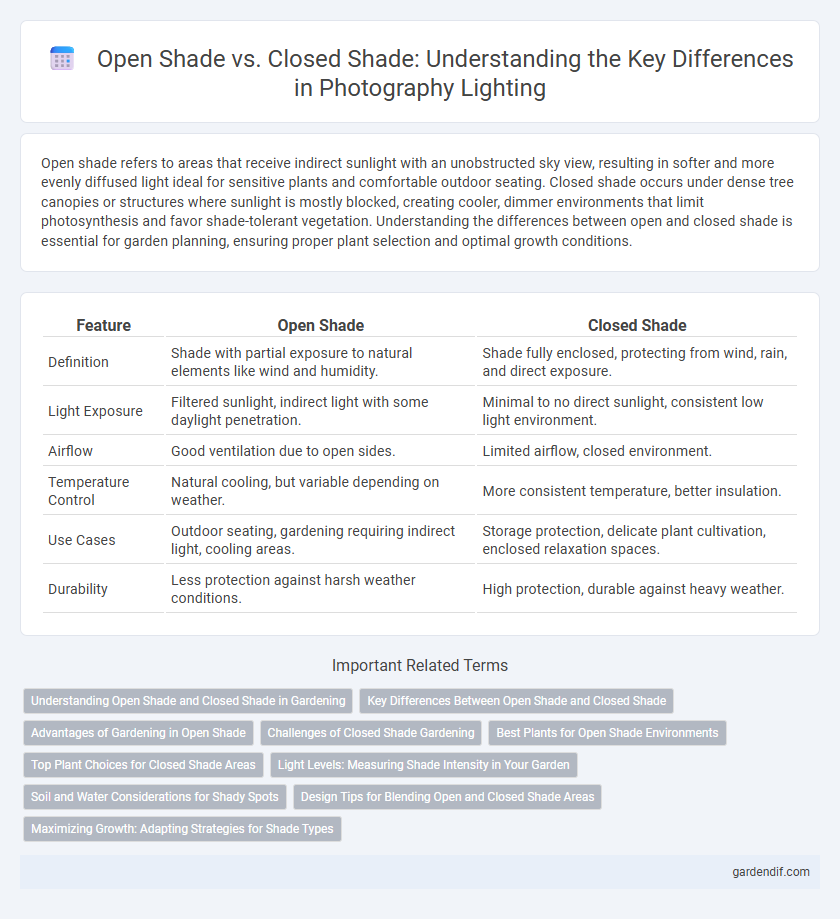
Open Shade vs Closed Shade Illustration
Open shade refers to areas that receive indirect sunlight with an unobstructed sky view, resulting in softer and more evenly diffused light ideal for sensitive plants and comfortable outdoor seating. Closed shade occurs under dense tree canopies or structures where sunlight is mostly blocked, creating cooler, dimmer environments that limit photosynthesis and favor shade-tolerant vegetation. Understanding the differences between open and closed shade is essential for garden planning, ensuring proper plant selection and optimal growth conditions.
Table of Comparison
| Feature | Open Shade | Closed Shade |
|---|---|---|
| Definition | Shade with partial exposure to natural elements like wind and humidity. | Shade fully enclosed, protecting from wind, rain, and direct exposure. |
| Light Exposure | Filtered sunlight, indirect light with some daylight penetration. | Minimal to no direct sunlight, consistent low light environment. |
| Airflow | Good ventilation due to open sides. | Limited airflow, closed environment. |
| Temperature Control | Natural cooling, but variable depending on weather. | More consistent temperature, better insulation. |
| Use Cases | Outdoor seating, gardening requiring indirect light, cooling areas. | Storage protection, delicate plant cultivation, enclosed relaxation spaces. |
| Durability | Less protection against harsh weather conditions. | High protection, durable against heavy weather. |
Understanding Open Shade and Closed Shade in Gardening
Open shade in gardening refers to areas where plants receive filtered sunlight or dappled light, typically under deciduous trees, allowing some sun exposure essential for growth. Closed shade involves spaces with dense canopy cover or structures blocking nearly all direct sunlight, resulting in cooler, moister conditions ideal for shade-loving plants like ferns and hostas. Understanding the differences between open and closed shade helps gardeners select appropriate plant species and optimize garden health by matching light requirements.
Key Differences Between Open Shade and Closed Shade
Open shade refers to areas receiving indirect sunlight with some exposure to diffuse light, ideal for plants requiring partial sunlight without intense heat. Closed shade involves spaces completely sheltered from direct and indirect sunlight, often under dense canopies, supporting shade-tolerant species adapted to low light conditions. Key differences include light intensity, temperature regulation, and plant suitability, with open shade offering moderate light and airflow, while closed shade maintains cooler, consistently dim environments.
Advantages of Gardening in Open Shade
Gardening in open shade benefits plants by providing filtered sunlight, which reduces heat stress and prevents leaf scorch compared to closed shade. This environment supports a wider variety of shade-tolerant plants due to better air circulation and intermittent light exposure. Open shade also helps conserve soil moisture, lowering irrigation needs and promoting healthier root development.
Challenges of Closed Shade Gardening
Closed shade gardening poses challenges due to limited sunlight penetration, which restricts photosynthesis and slows plant growth. High humidity and poor air circulation in densely shaded areas increase susceptibility to fungal diseases and pest infestations. Selecting shade-tolerant plant species and managing soil moisture effectively are critical to overcoming these obstacles.
Best Plants for Open Shade Environments
Open shade environments, characterized by dappled sunlight or partial shade for several hours daily, support a diverse range of plants that tolerate indirect light and moderate moisture. Ideal plants for open shade include hostas, ferns, astilbes, bleeding hearts, and woodland phlox, all of which thrive without direct sun exposure and enhance garden texture and color. These plants adapt well to shaded garden beds, providing lush foliage and vibrant blooms even in filtered light conditions.
Top Plant Choices for Closed Shade Areas
Top plant choices for closed shade areas include hostas, ferns, and astilbes, which thrive in low light and high humidity conditions. Shade-loving groundcovers such as pachysandra and ajuga provide dense foliage that enhances soil moisture retention and reduces erosion. These plants adapt well to closed shade environments created by dense tree canopies, offering vibrant textures and colors without requiring direct sunlight.
Light Levels: Measuring Shade Intensity in Your Garden
Open shade allows filtered sunlight through gaps in foliage, resulting in moderate light levels ideal for plants that need partial sun, typically ranging from 2 to 4 hours of direct sunlight daily. Closed shade blocks most direct light, producing low light intensity with less than 2 hours of sunlight and predominantly diffuse light, suitable for shade-tolerant species. Measuring shade intensity using a light meter helps gardeners optimize plant placement by quantifying lux or foot-candle levels in both open and closed shade areas.
Soil and Water Considerations for Shady Spots
Open shade allows more sunlight penetration, promoting better soil aeration and moisture retention, which supports healthier root development in plants. Closed shade often results in denser canopy cover, reducing water evaporation but increasing soil compaction and limiting nutrient availability. Understanding the balance between light exposure and soil moisture dynamics is crucial for optimizing plant growth in shaded environments.
Design Tips for Blending Open and Closed Shade Areas
In landscape design, blending open shade and closed shade areas requires careful plant selection and layering to create seamless transitions between light levels. Use shade-tolerant groundcovers and understory shrubs to soften edges where open shade meets dense canopy, ensuring varied textures and foliage shapes enhance visual interest. Incorporate structural elements like pathways or low walls to define zones while maintaining cohesion across different shade types.
Maximizing Growth: Adapting Strategies for Shade Types
Maximizing growth under open shade involves selecting shade-tolerant plants that thrive with filtered sunlight and ensuring adequate air circulation to prevent fungal diseases. For closed shade, strategies emphasize choosing species with high low-light endurance and improving soil fertility to support healthy root systems in consistently shaded conditions. Adjusting watering schedules and utilizing reflective mulch can further enhance plant development in both shade types.
Open Shade vs Closed Shade Infographic

 gardendif.com
gardendif.com